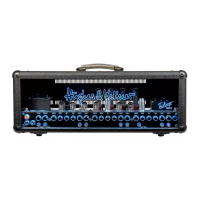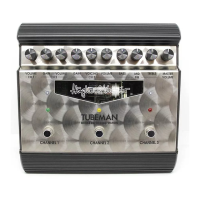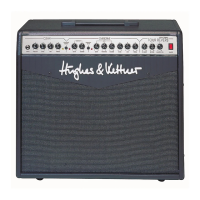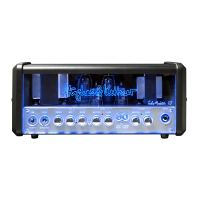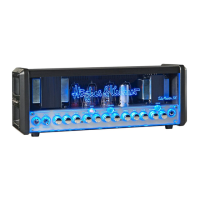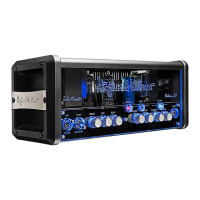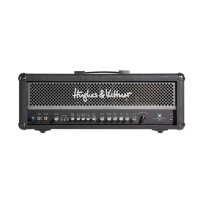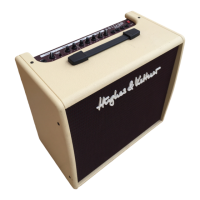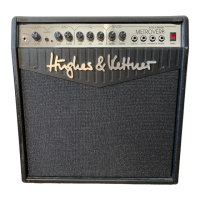1's socket so that the color-coded wire faces the notch on
the socket.
MSM-1 socket and indicator notch.
- Insert the MSM-1 into the module port, and affix it in place
using the same four screws you just removed a moment ago.
Make sure the writing on the MSM-1 reads in the same
direction as that on the rest of the chassis back.
Location of the sockets.
- On the control circuit board you will find the socket for the
connector on the other end of the ribbon cable. Also insert
this connector in the socket so that the color-coded wire
faces the notch on the socket.
- Double-check that the module and the connectors are
seated correctly.
- Replace the chassis in the housing and, if you removed the
tubes, the tubes in the chassis.
- Replace the amp's rear panel, and reconnect the cables to
the reverb and speakers.
- To use the MIDI LEARN function with the TriAmp, please
refer to the instructions included with the MSM-1 MIDI
Module. The moment power is applied to the amp, the MIDI
functions of the TriAmp are immediately available. Please
check all switching functions of the amp.
9
TRIAMP - Manual
Abb.7
4.3 THE RED BOX DI OUT
- ALL-TUBE TONE TO THE MIXER
The balanced RED BOX DI OUT allows you to connect
TriAmp's output signal directly to a mixing console, for the
smooth, rich sound of a miked-up cabinet without the
hassles of actually using a microphone. The integrated RED
BOX circuitry is in-line with the speaker output for optimum
audio results, allowing the character of the connected
speaker to come through to as great a degree as possible.
WARNING: Never run the amp without a load (a connected
speaker cabinet), even in a recording situation. Doing so
risks serious damage to the amp's all-tube output stage.
NOTE: Speakers, in combination with a tube amp's output
transformer, may demonstrate microphonic properties. If
your amp's master setting is extremely low and the PA is
very loud, you may encounter feedback through the DI OUT
circuit. This effect does not occur at normal stage volumes.
However, we do recommend you use the STANDBY switch
rather than turning the MASTER down to silence your amp
during breaks.
If this feedback problem does occur at some point, simply
turn the amp's master volume up. The speaker then loses the
microphonic properties and the feedback will stop.
4.4 TRIAMP AND MIDI
With the MSM-1 MIDI Module installed, you can use your
multi-effects processor to select TriAmp channels and turn
the FX LOOP on or off via MIDI.
Installing the MSM-1 MIDI Module
NOTE (VERY IMPORTANT): The following instructions are
intended solely for a factory authorized technician.
- Unplug the amp's mains cord from the wall socket and
remove all connected cables (e.g. to the spring reverb or
speakers).
- Remove the amp's rear panel cover so you can access the
tubes.
- Prepare a suitable spot to set the amp chassis (for instance
two books placed the same distance apart as the two
transformers), or remove the power amp tubes.
- Remove the four retaining screws that hold the chassis in
place, and carefully pull the amp chassis out of the wood
housing.
- Remove the MIDI Module port cover plate from the rear
panel of the chassis.
- Insert the included flat cable connector plug in the MSM-
Abb.6

